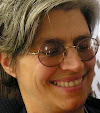 My weekly tutoring gig with "Artemis" is going well. When we started, he didn't know much algebra, didn't really understand distributing. He's learned distributing mostly through experimenting, and has learned an amazing amount of algebra through playing with his TI-84. (I wrote about the first time we played with the calculator here.)
My weekly tutoring gig with "Artemis" is going well. When we started, he didn't know much algebra, didn't really understand distributing. He's learned distributing mostly through experimenting, and has learned an amazing amount of algebra through playing with his TI-84. (I wrote about the first time we played with the calculator here.)He loves coming in with graphs on his TI and getting me to guess the function. Here's the one he started with last week. (I got it. Can you?) I showed him some similar graphs to see how well he could do. He got them all. (I told his mom I figured we were into what would normally be the third year of algebra, after about two months of untutoring.)
I never have a lesson prepared for him, and we often go into college algebra sorts of topics (it's called math analysis in high school), riffing off those graphs. Some weeks I worry that we won't have a path in to good topics just by our inspirations. But it always seems to work out that we do something solid.
I know all kids wouldn't move this fast, but to me this demonstrates the power of play. That's all we're doing, playing with ideas...
My Other Student
R comes for tutoring about once a month. (I think it's a special treat for him.) He and I have been playing with Kenken and logic puzzles. He decided last week that he wanted to make his own Kenken puzzle. Yeay! That sounded like something Maria Droujkova would have suggested, but that I don't think of so readily myself. So we did it. We started with one box, and figured out what had to be true. Our puzzle isn't standard because we didn't give a total for many of the boxes. If you think about what has to be, you'll figure them out.
Here's the puzzle R
 and I made...
and I made...[I used Excel to make it pretty like this, and used print to save as a pdf. I learned that my blog doesn't want pdf's - it wants jpegs. So I saved the pdf as a jpeg. I don't see a jpeg option in Excel, so that might be the best way to do it...]
Anyone else want to try their hand at making their own kenkens?



